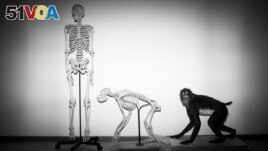Our very ancient animal ancestors had tails. Why don't we have them now?
From the time of Charles Darwin, a scientist from the 1800s who studied evolutionary biology, scientists have questioned why and how this happened.
The answer is somewhere around 20 million or 25 million years ago. That was the time apes, the group of animals humans are part of, split from another animal group, monkeys. During that split, our branch of the tree of life lost its tail.

FILE - Skeletons of a human and a monkey await installation at the Steinhardt Museum of Natural History in Tel Aviv, Israel on Monday, Feb 19, 2018. (AP Photo/Oded Balilty, File)
Now, scientists have identified at least one of the genetic differences that led to this change.
"We found a single mutation in a very important gene," said Bo Xia. He is a geneticist at the Broad Institute and helped write the study recently released in the publication Nature.
The researchers compared the genomes of six kinds of apes, including humans, and 15 kinds of monkeys with tails to find important differences between the groups. Once they identified an important mutation, they tested their theory by using the gene-editing tool CRISPR. They used it to change the same place in embryos of an animal often used in laboratories, mice. Those mice were born without tails.
Xia said, however, that other genetic changes may also play a part in losing tails.
Another mystery: Did having no tails help these ape ancestors – and eventually, humans – survive? Or was it just a chance mutation in a population that survived for other reasons?
"It could be random chance, but it could have brought a big evolutionary advantage," said Miriam Konkel. She is an evolutionary geneticist at Clemson University, who was not involved in the study.
As to why having no tails may have helped our ancestors, there are many interesting theories. They include some that link being tailless to learning to walk upright.
Rick Potts directs the Human Origins Project of the Smithsonian Institution in Washington, D.C. He was not involved in the research. Potts suggests being tailless may have been a first step toward some apes standing upright, even before they left the trees.
Not all apes live on the ground today. Orangutans and gibbons are tailless apes that still live in trees. But Potts notes that they move very differently than monkeys, who move along the tops of branches, using their tails for balance. Those apes hang below branches, holding onto the branches with their arms while hanging largely upright.
New York University biologist Itai Yanai helped write the study. He said that losing our tails was clearly a large change. But the only way to truly know the reason "would be to invent a time machine," he said.
I'm Gregory Stachel.
Christina Larson reported this story for The Associated Press. Gregory Stachel adapted it for VOA Learning English.
________________________________________________
Words in This Story
tail – n. the part of an animal's body that extends from the animal's back end
mutation – n. the part of an animal's body that extends from the animal's back end
edit – v. to make changes
embryo – n. a human or animal in the early stages of development before it is born or hatched
random – adj. in a way that does not follow a particular plan or pattern
advantage – n. something (such as a good position or condition) that helps to make someone or something better or more likely to succeed than others
